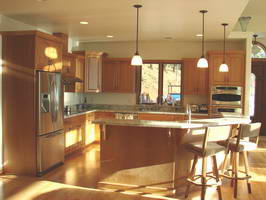How do I install a fixture box for my outside light?
 '; ';
|
There are a variety of fixture boxes that can be used for just about any wiring situation. If the 2×6 is directly at the desired location for the light fixture then… © By: Dave Rongey |
Electrical Question from Gary about Home Electrical Wiring
Background: Gary, a Handyman from Mays Landing, New Jersey.
[ad#block]Question: I want to install lights on both sides of my garage door to the exterior of my home.
One side is relatively straight forward as it is typical stud construction. The other side has a pressure treated 2×6 behind the location on the wall which forms a mounting space for the garage track. What do I do? Should I use conduit to come out of the back of a box as the wires would not be in a cavity? Should I use and extra deep box?
Dave’s Reply:
Thanks for your electrical question Gary. There are a variety of fixture boxes that can be used for just about any wiring situation. If the 2×6 is directly at the desired location for the light fixture then a hole saw can be used to create the necessary opening for the fixture box. If the space is partially blocked by a framing stud then install a thin pancake box. If the space is wide open then use a cut-in box. Follow the link below for full details about junction boxes.
The Following resources will assist you with your electrical question:
Electrical Junction Boxes
For more information about Home Wiring
Home Wiring Diagrams
This link is helpful as a Handyman
Do-It-Yourself Electrical
Make sure not to miss these Resources for: How-To-Videos
Electrical Videos
Be Careful and Be Safe – Never Work on Energized Circuits!
For Best Results Consult a Licensed Electrical Contractor.
Locate An Electrical Contractor in Your Area
The following may also be helpful for you:
Be Careful and Be Safe - Never Work on Energized Circuits!
Consult your Local Building Department about Permits and Inspections for all Electric Wiring Projects.
More articles about Electrical, Lighting, Outdoor Lighting and Home Electrical Wiring: |
|
| « Previous | Next » |
How to convert a 240 volt outlet into a sub-panel |
What is the formula for the computations of main wire? |













